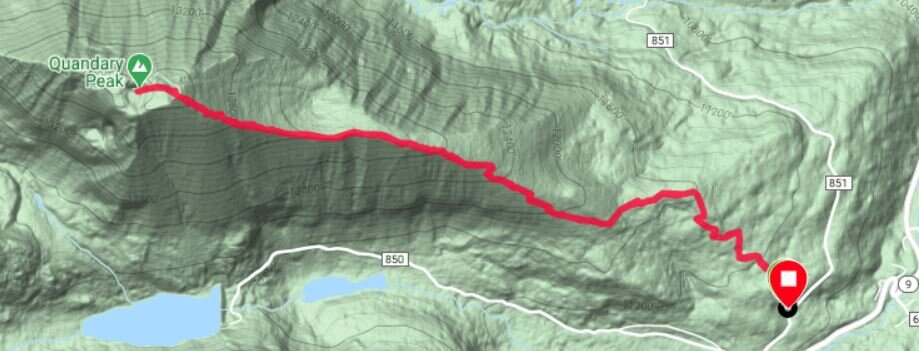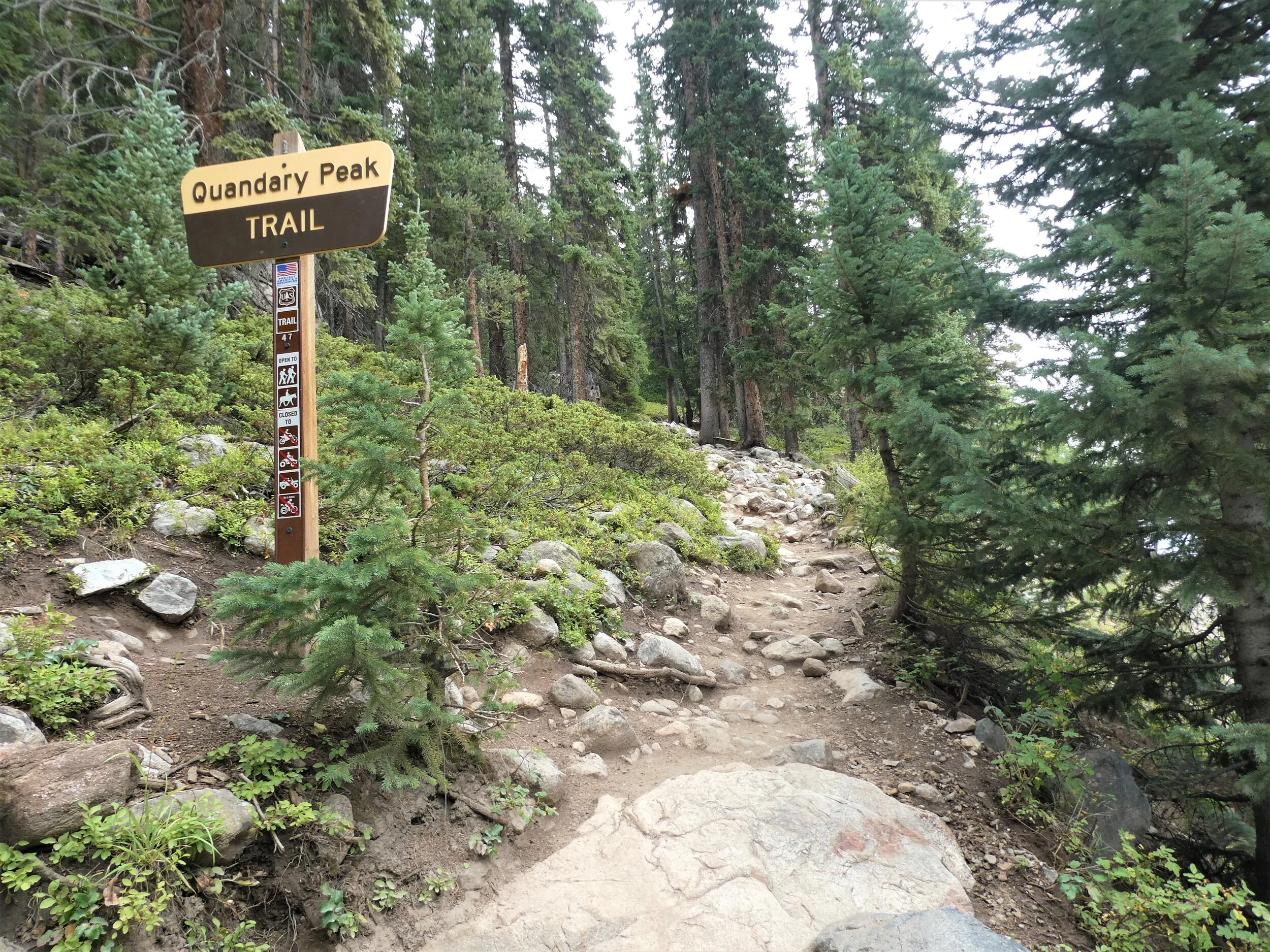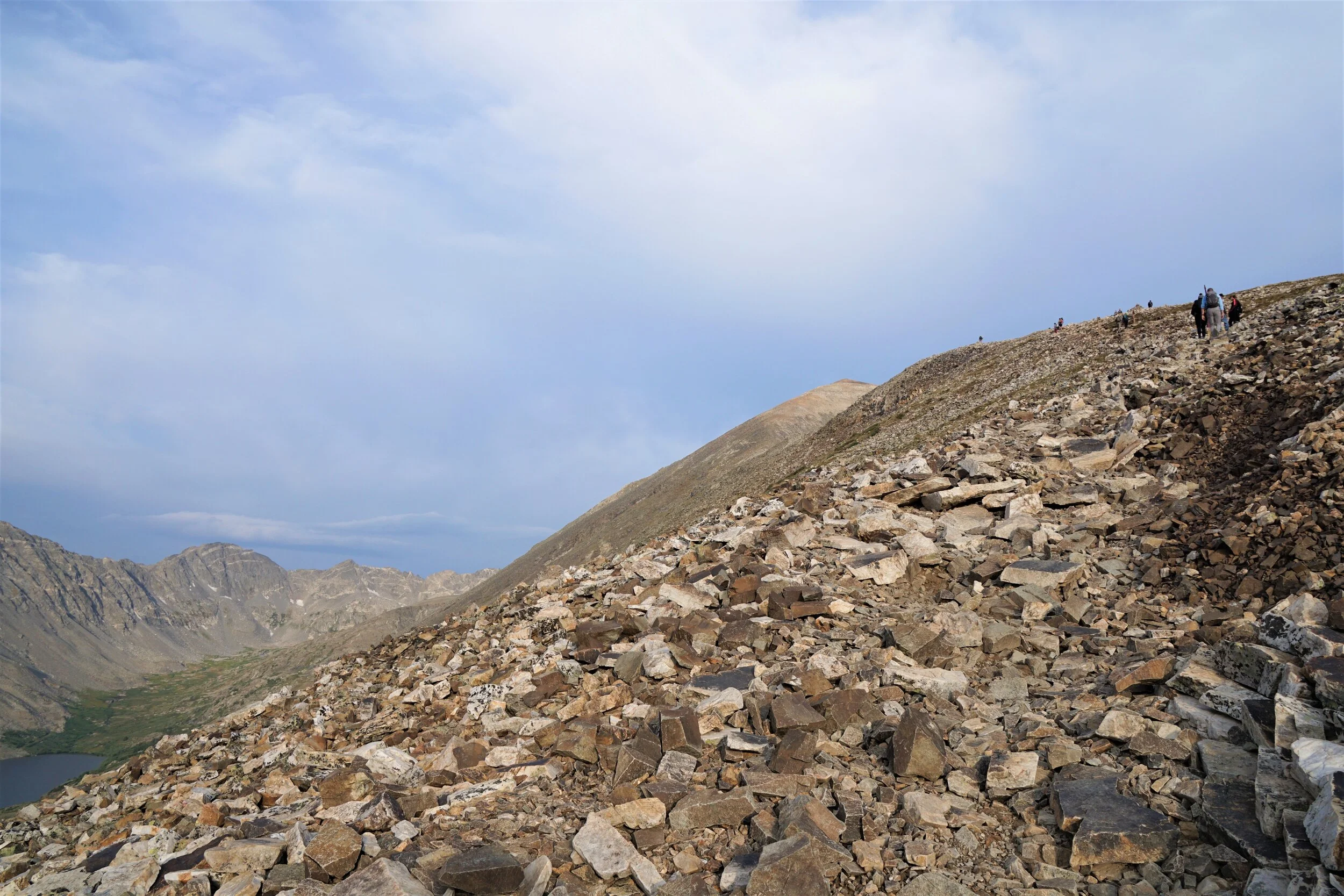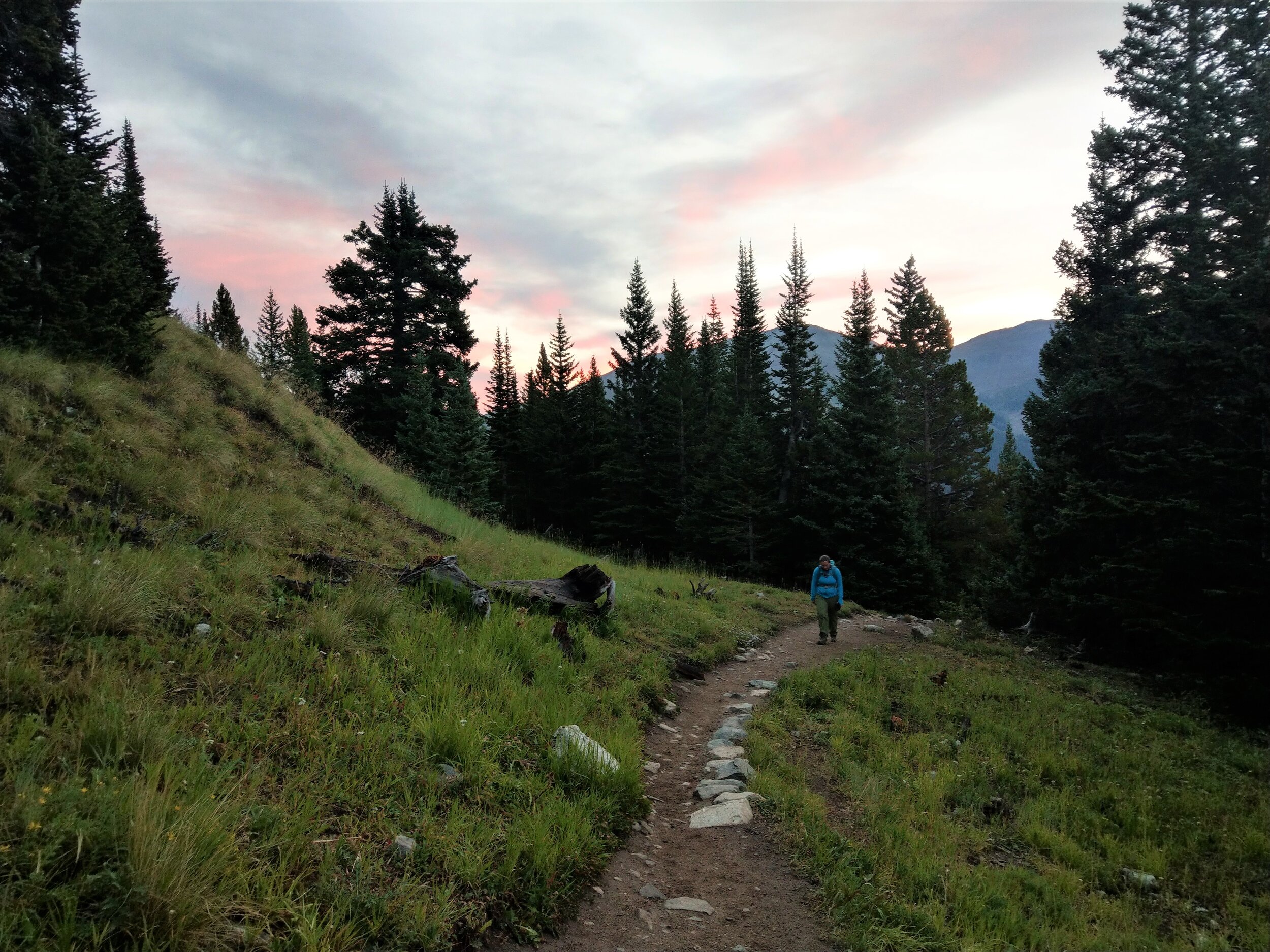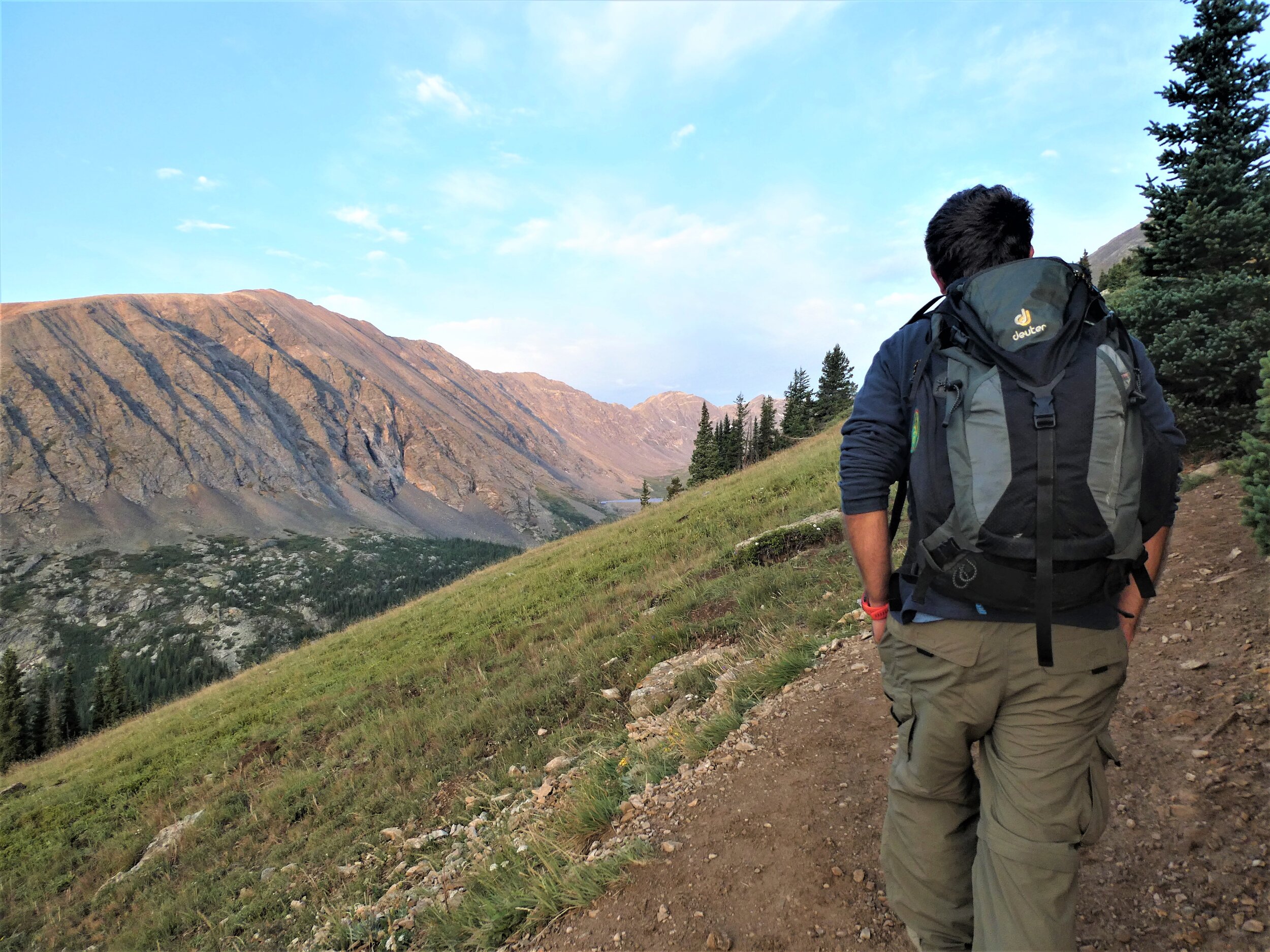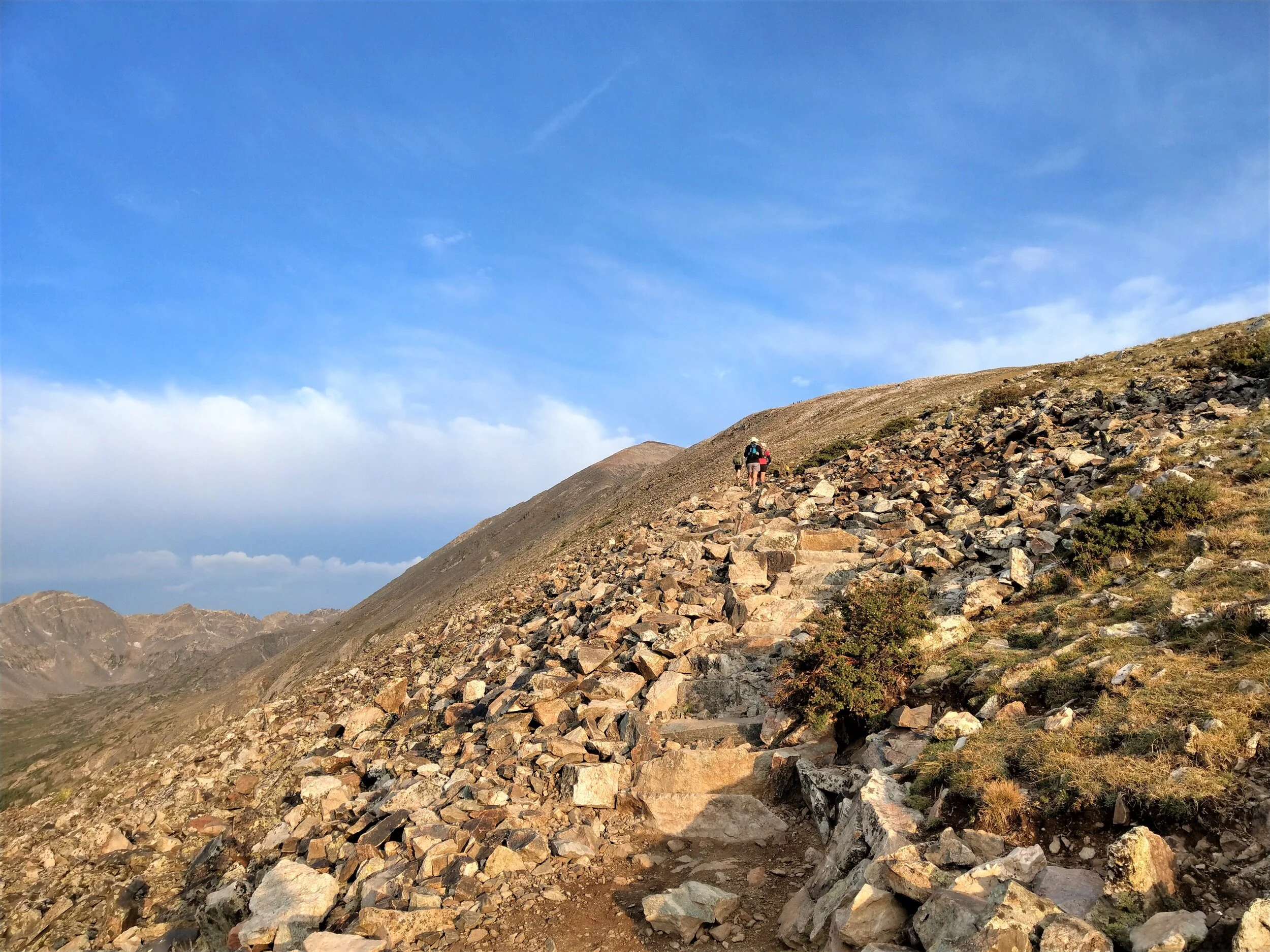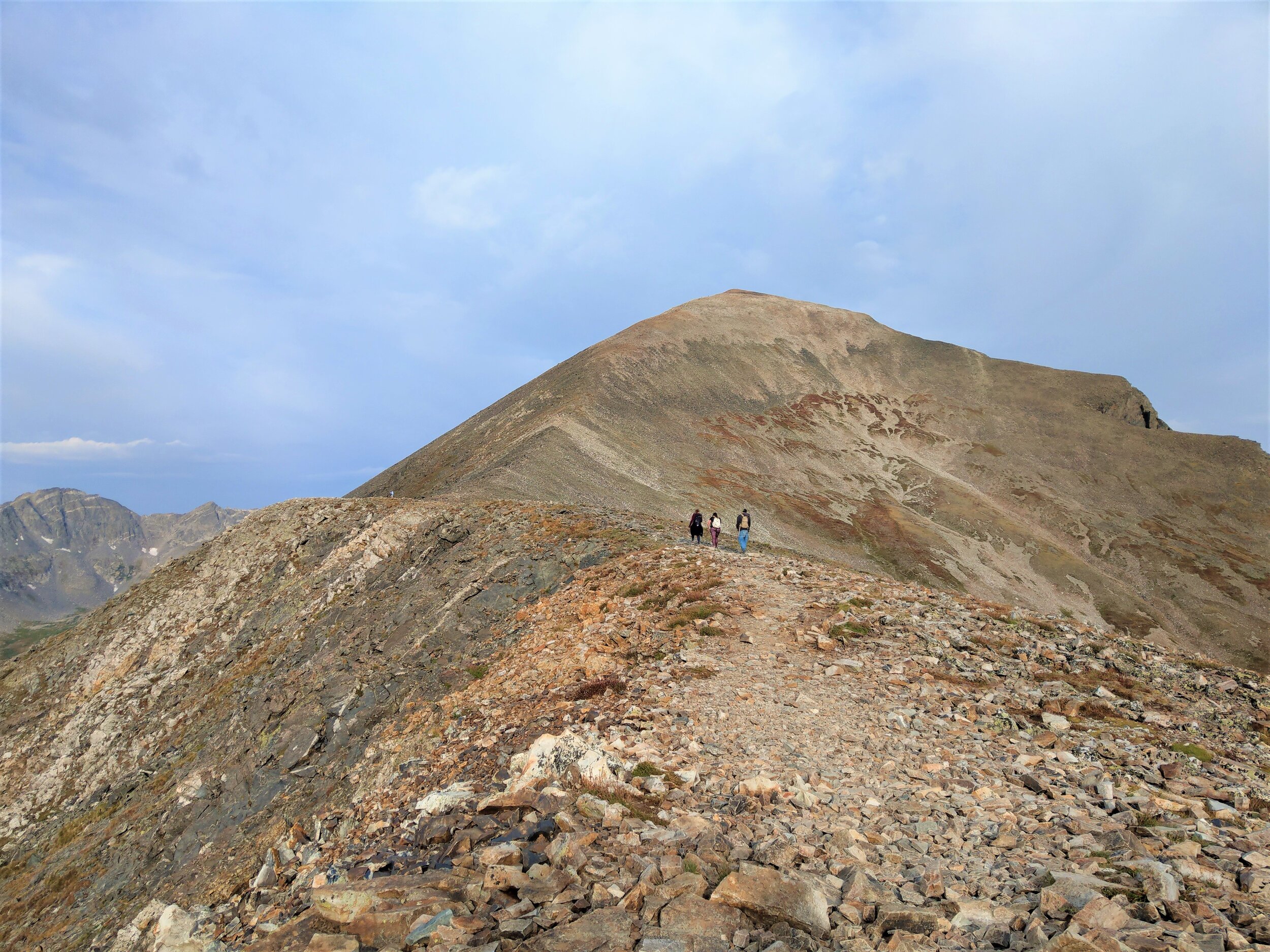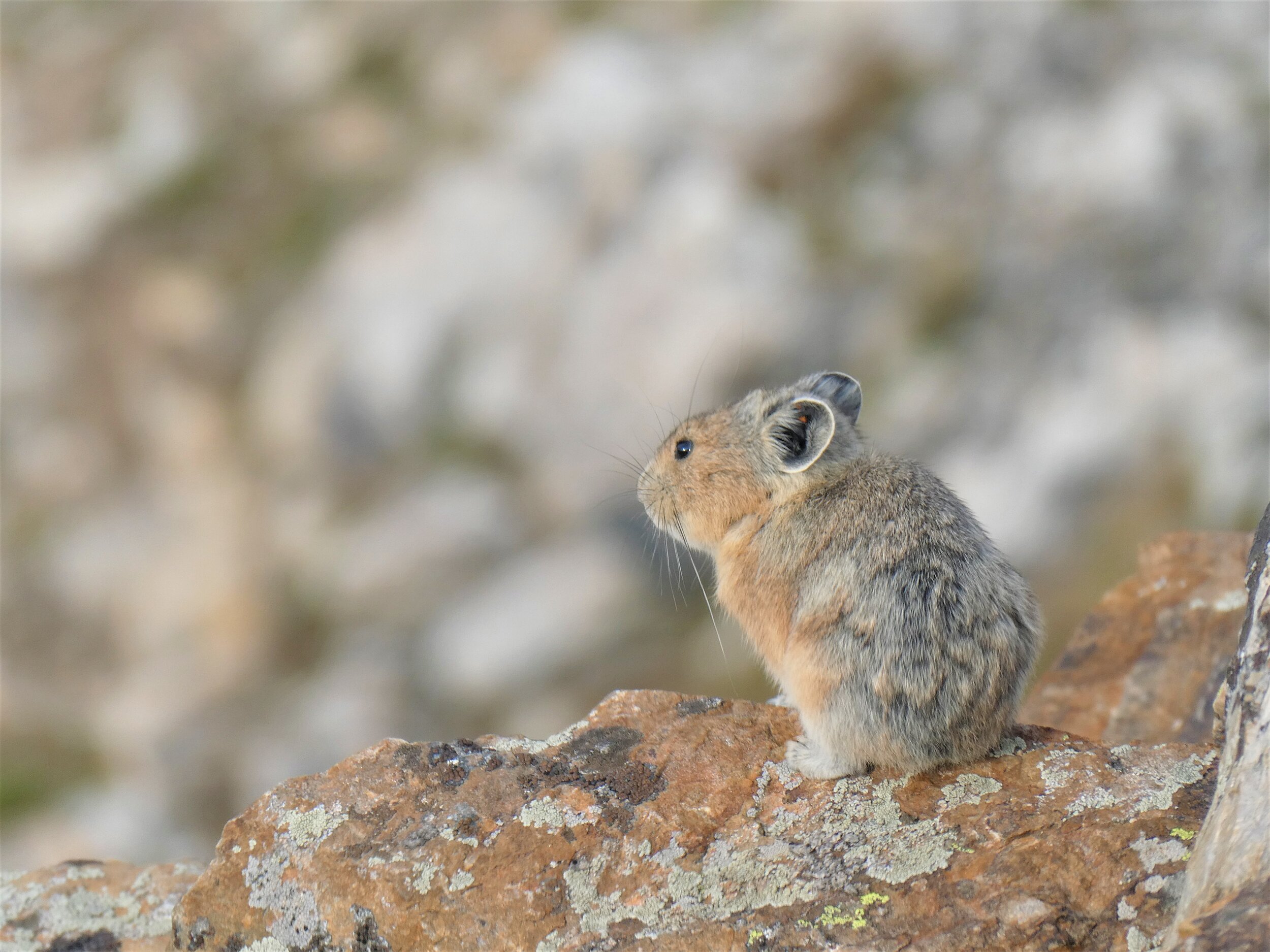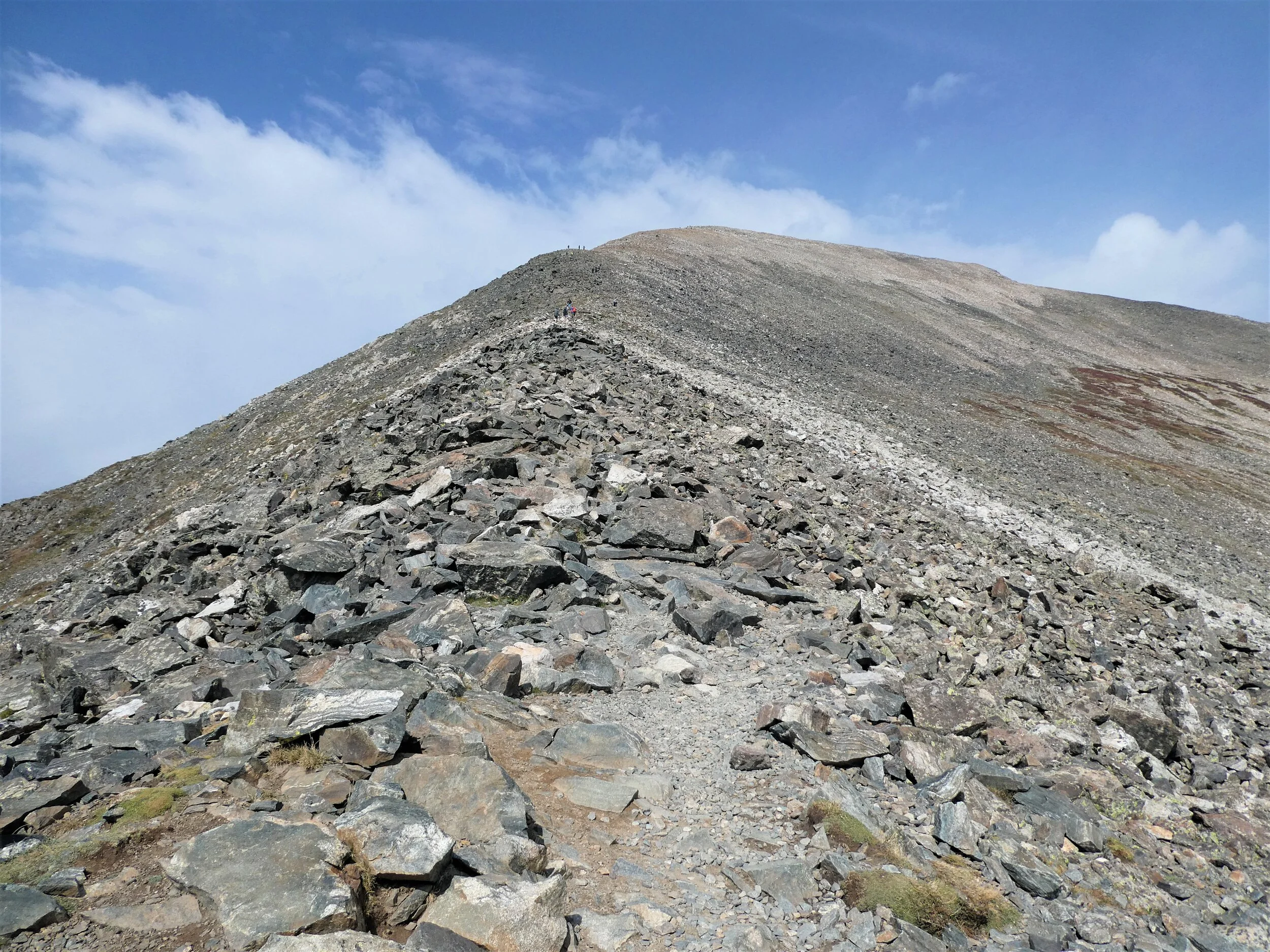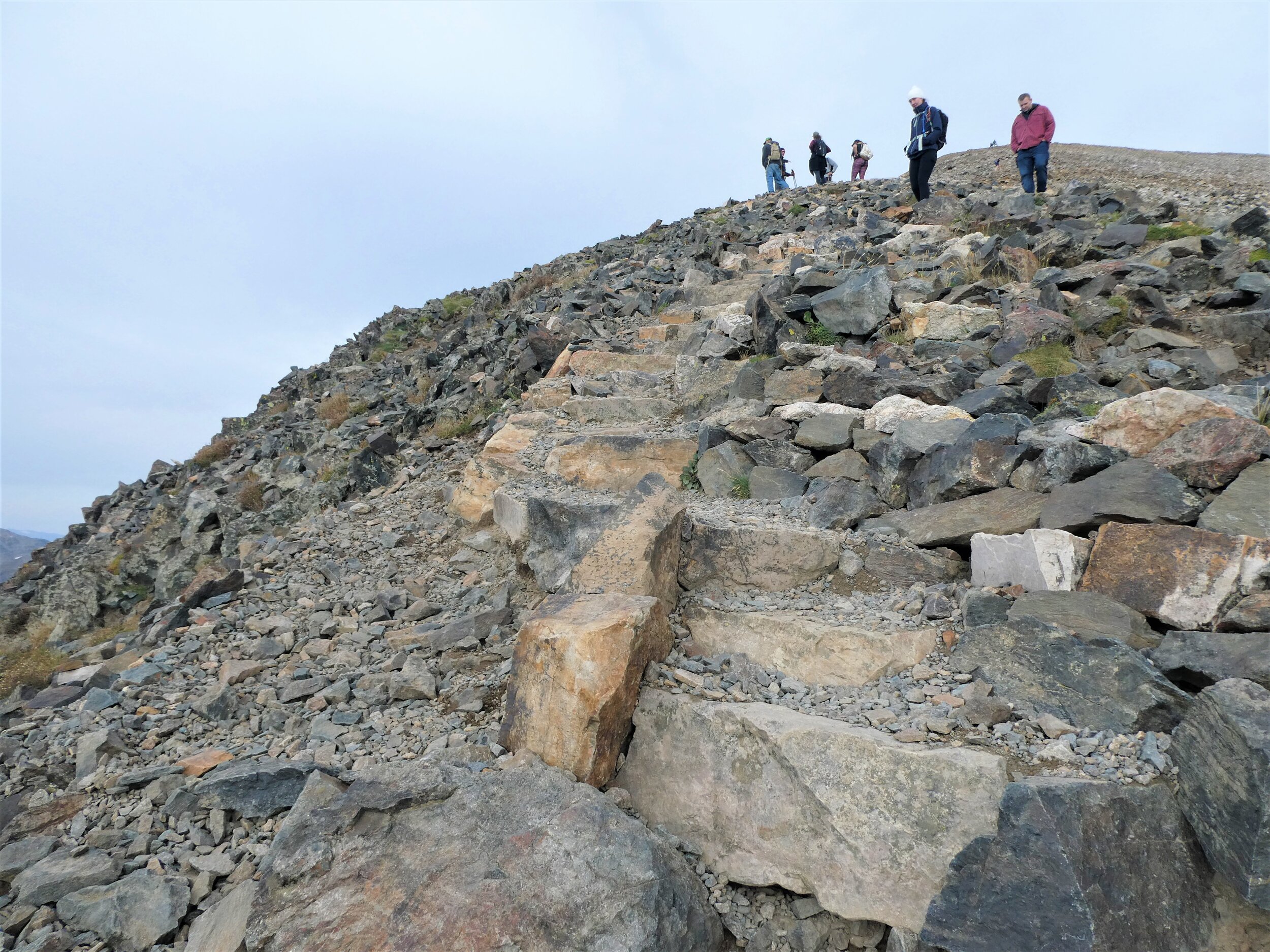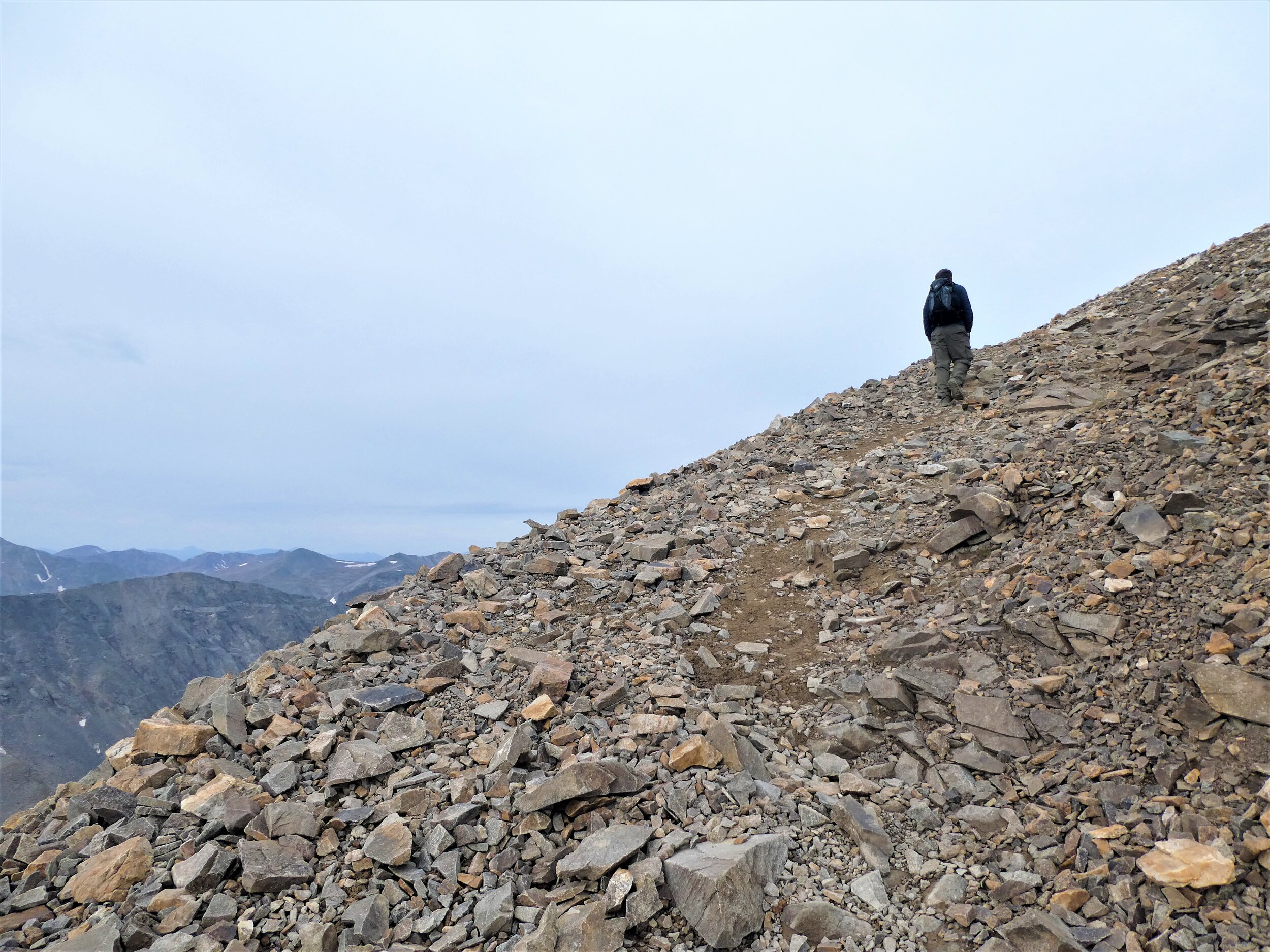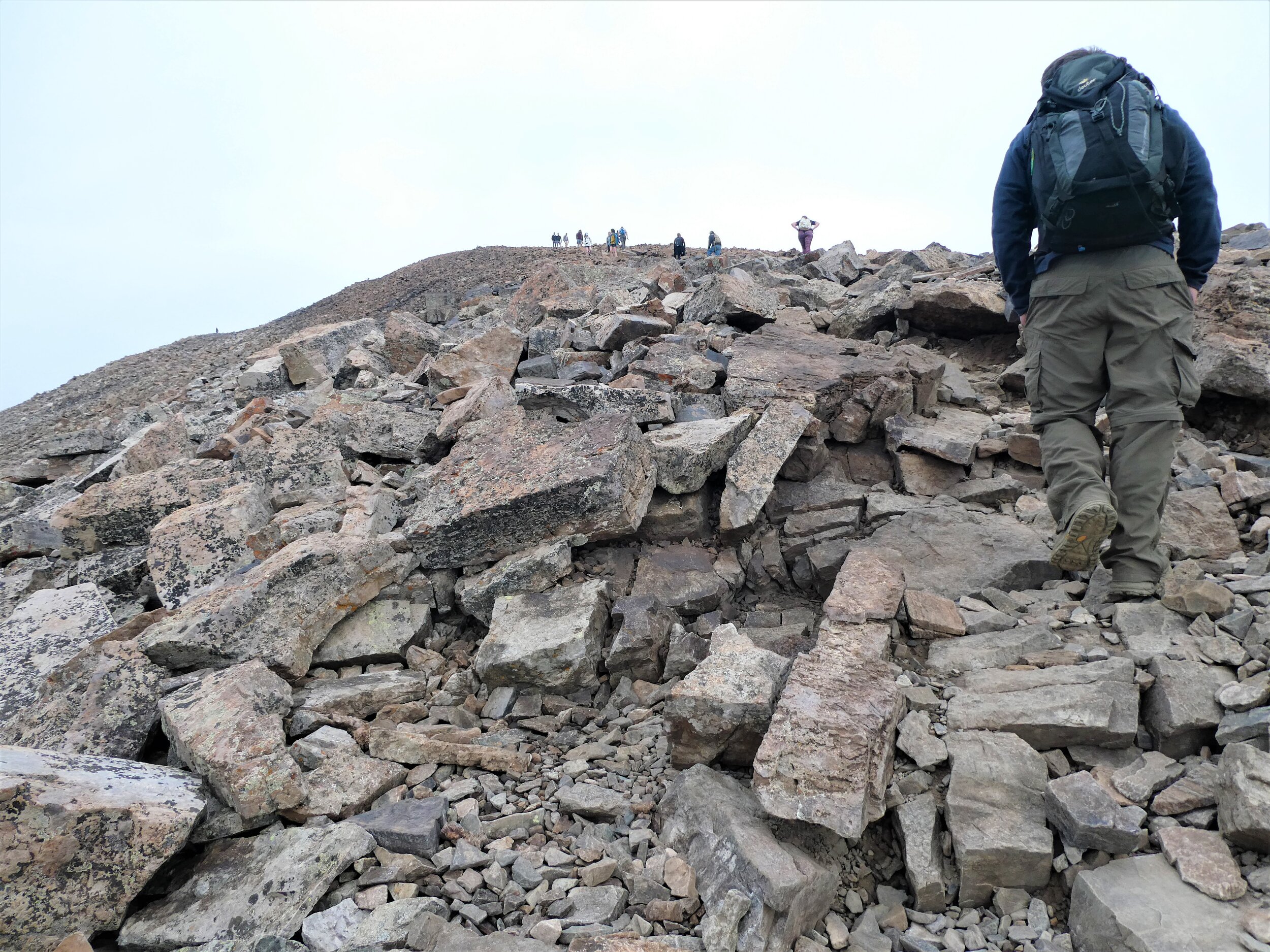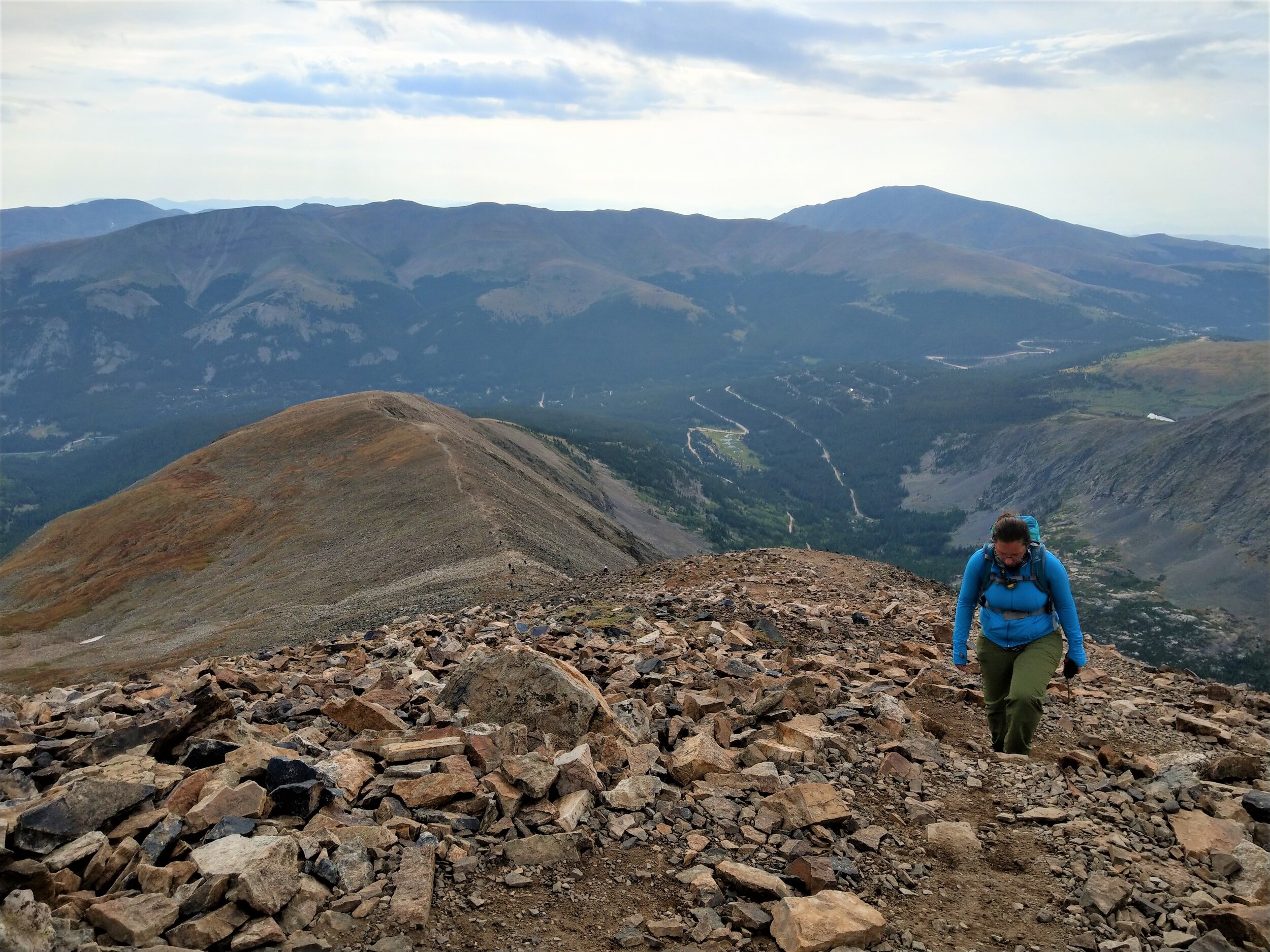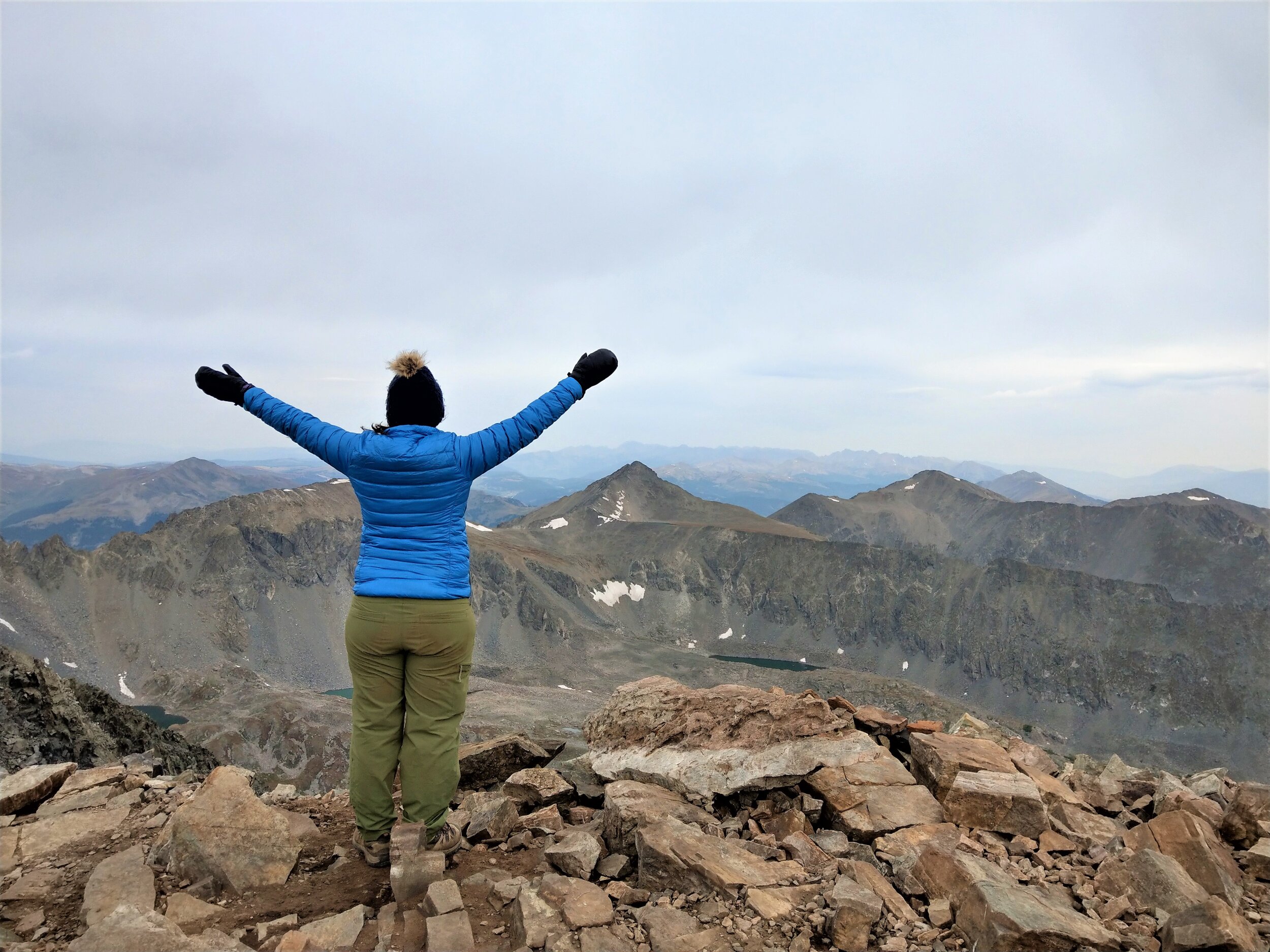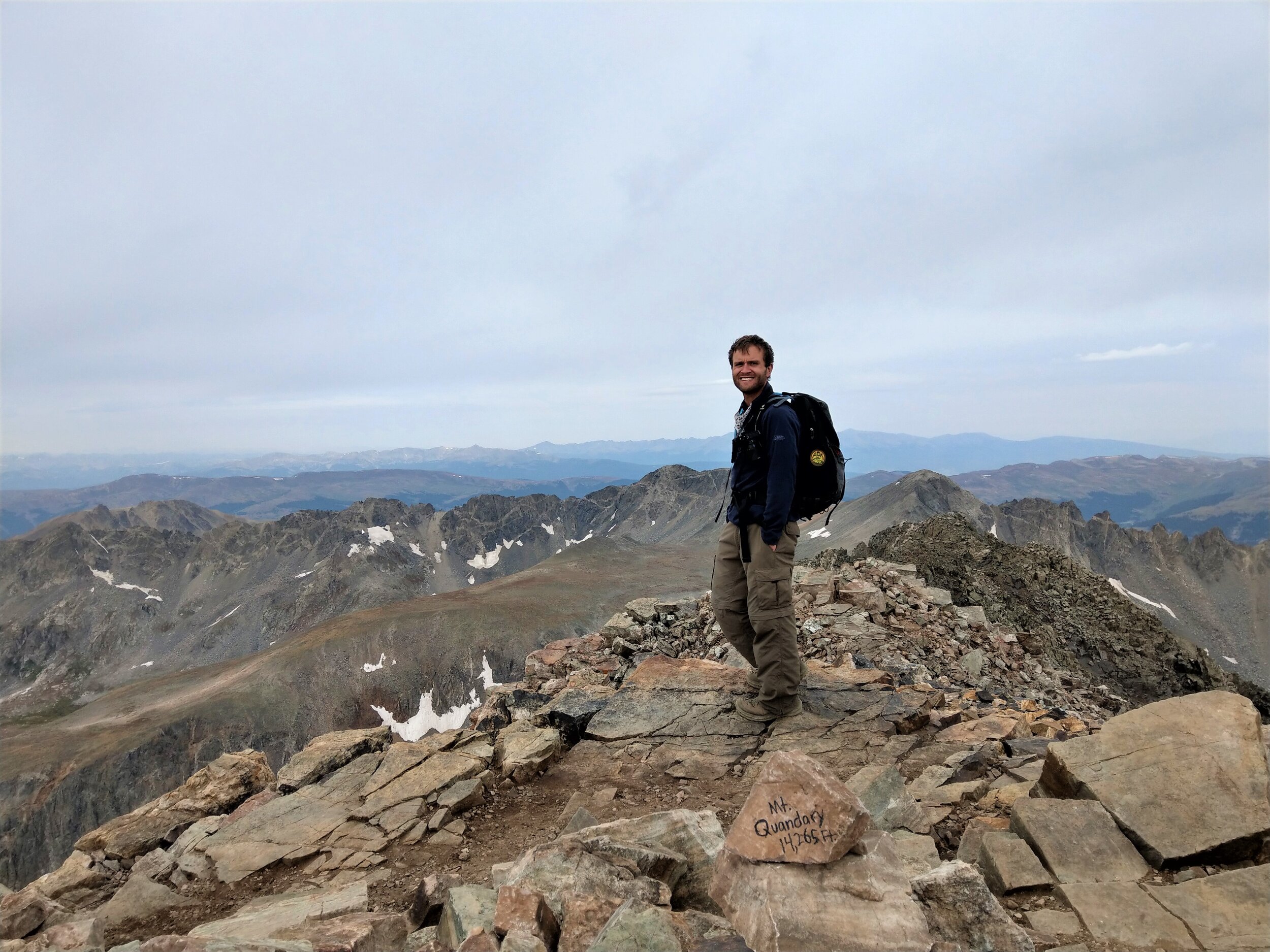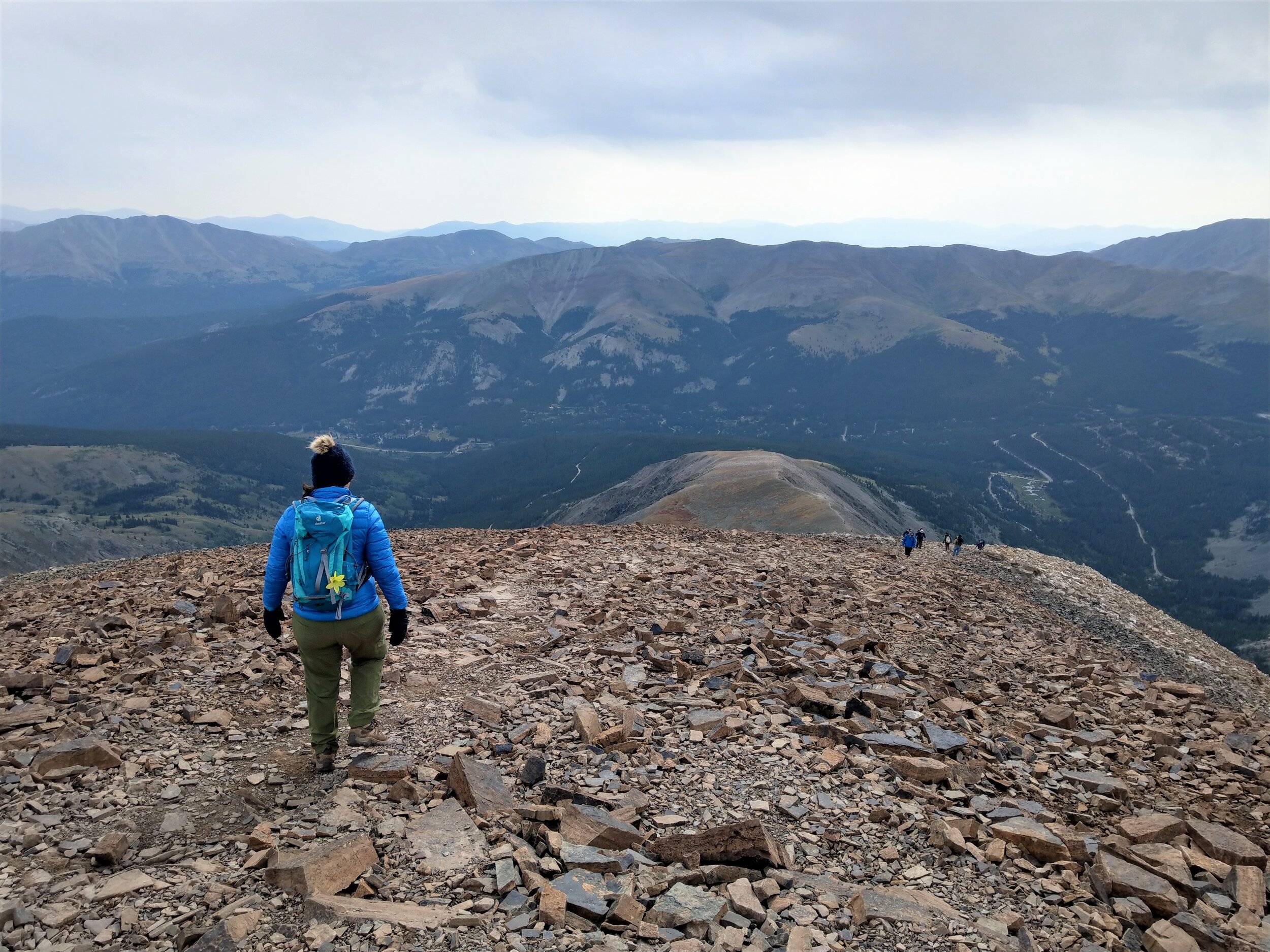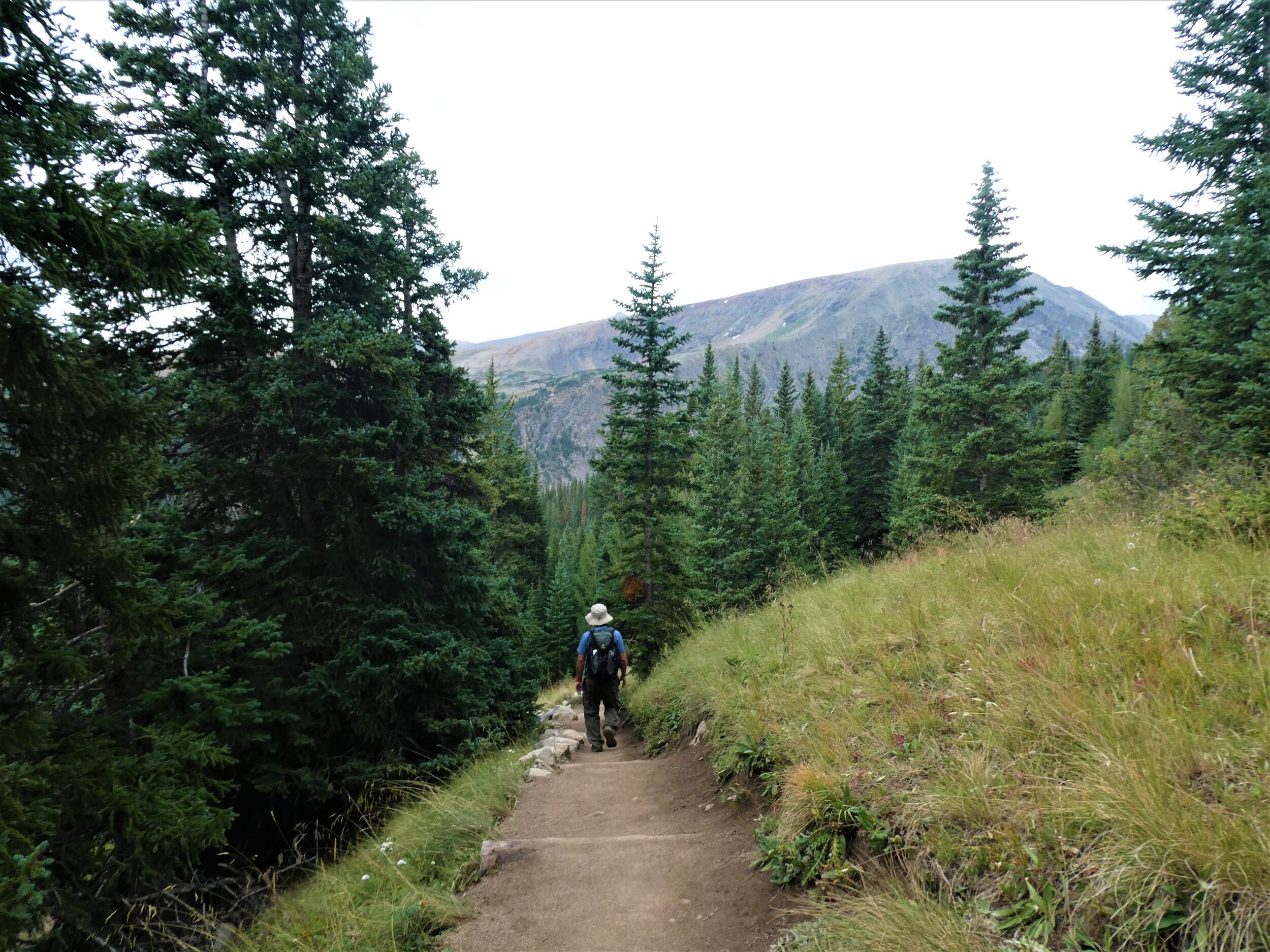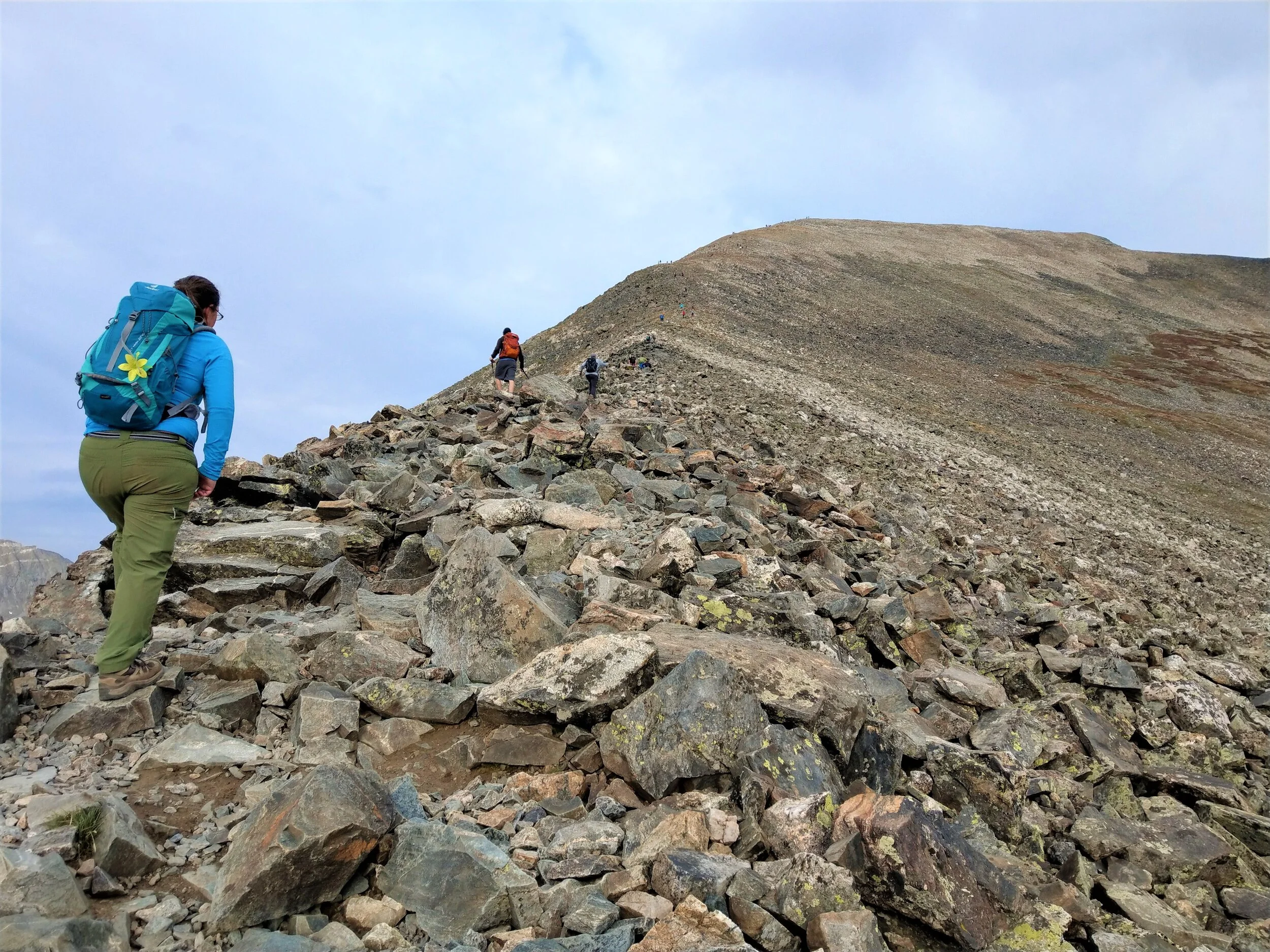The Hike to Quandary Peak: A Great Mountain for Your First 14er in Colorado
Ah, the 14ers of Colorado. Climbing all 58 peaks in Colorado over 14,000 feet is a lofty goal of many avid and experienced hikers, and usually at least a few of these mountains make it onto the list of even the less experienced. Tackling a 14er and standing on top of the world (at least for United States standards!) is an awesome hiking goal, and comes with great views and an even greater sense of accomplishment.
If you’re just starting out on your journey to hike the 14ers, or if you’re just a recreational hiker who is visiting Colorado and looking for a challenge, there are a handful of mountains that are great choices for hiking your first 14er in Colorado. These mountains don’t require any technical or mountaineering experience, just a good level of fitness and endurance, acclimation, and the will to make it to the summit!
Quandary Peak, the 13th highest peak in Colorado, is a great first 14er to hike in Colorado…many first time 14ers can be found scaling the mountainside up to the summit. The East Ridge route is a standard hiking trail with no technical features, and it’s on the shorter side in terms of distance and elevation gained, but the reward at the top includes an incredible 360 view of Colorado’s Ten Mile Range.
While Quandary Peak was not our very first 14er ever (that title belongs to Mt. Whitney in California!), it was indeed our first Colorado 14er, and we can speak from experience that it’s a great introduction to these high- altitude peaks.
Of course, it certainly won’t be a walk in the park either! In this article, we’ll go over everything you need to know for hiking Quandary Peak and what to expect on the trail to this popular 14er summit.
Article Contents
Which trail to hike Quandary Peak
Quandary Peak hiking stats
Quandary Peak trailhead
Why choose Quandary Peak for your first 14er?
Is the Quandary Peak hike easy?
Crowds on Quandary Peak
Best time to hike Quandary Peak
Hiking Quandary Peak - an overview
What to pack for Quandary Peak
Where to stay near Quandary Peak
Tips for hiking Quandary Peak
Want to save for later? Pin this post and come back when you’re ready!
Which Trail Should I Hike on Quandary Peak?
You might have noticed that there are a few different route options for the hike up to Quandary Peak. We hiked the East Ridge route, and if this is one of your first 14ers and you don’t have much or any mountaineering experience, this is what we recommend you hike as well.
The East Ridge trail is simply a hike with no technical sections and requires no mountaineering experience. The trail is very well trodden and easy to follow and there are always a lot of people here. The other routes, such as the West Ridge route, are technical, with Class 3 scrambling and high exposure and are only for those who are looking for a true mountaineering experience.
Quandary Peak Hiking Stats
These numbers are taken from our Garmin watch and describe the East Ridge route.
Trail type: Out and back
Distance: 6.85 miles round trip
Elevation Gain: 3,270 feet (This is usually quoted at more like 3400 feet, so our watch may have been a little off)
Trailhead Elevation: 10,953 feet
Summit Elevation: 14, 248 feet
Time to Hike: 6 hours (our total time, which includes 3.5 hours up, 2 hours down, and about 30 minutes enjoying those hard- earned summit views)
Trail Profile:
How to Get to the Quandary Peak Trailhead
To find the Quandary Peak Trailhead for the East Ridge route, you can follow the directions from Google Maps when you search for the destination “Quandary Peak Trailhead, Mc Cullough Gulch Rd, Breckenridge, CO 80424” (when you start typing Quandary Peak Trailhead in the search bar in Google Maps, this one should automatically come up).
The trailhead is located about 9 miles south of Breckinridge down route 9. You’ll turn onto route 850 (Blue Lakes Road). You’ll pass by a parking lot and then right after turn onto route 851 (Mc Cullough Gulch Road). This road will be unpaved…it’s a little bumpy but completely doable in a 2WD car. There will be a very small parking area on the right just before the trailhead that can fit a handful of cars, but there are quite a bit of places to park along the road on the left-hand side before and after the trailhead, which is what we ended up doing since the small lot was already full when we got there.
If you can’t find any safe off- road parking when you get there, then you can always park at the bigger lot that you passed on route 850. It’s just a 0.3 mile walk from there to the trailhead with a 100 foot elevation gain.
How early should you get to the Quandary Peak Trailhead?
Before hiking Quandary Peak, we heard that it was an incredibly busy mountain, and even on weekdays it’s necessary to get there very early in order to get a spot by the trailhead and beat the bulk of the crowds. We got to the trailhead on a Friday at 5:45 am. The small lot across the street from the trailhead was full, not surprisingly, but we were able to find a spot off road right next to the trailhead without a problem.
Generally, your best bet is to get there as early as you can, not only to get good parking, but also to get an early start on the trails so that you can be off the summit by noon and get back below tree line before any afternoon thunderstorms roll through.
What Makes Quandary Peak a Good First Colorado 14er?
We had a couple of peaks in mind for our first Colorado 14er, but we ultimately settled on Quandary Peak for a few reasons:
Quandary Peak’s East Ridge route is a straightforward Class 1 hike, requiring no technical climbing or exposure. We wanted to make sure we were safe and could get acquainted with these mountains on our first trip to Colorado before we attempted anything too technical.
It’s relatively low distance and elevation gain compared to many other 14ers. We were doing a lot of hiking on our short trip to Colorado and wanted to save some energy to do everything we wanted. Meaning, we didn’t want to do a double- digit mileage/4500+ foot elevation gain day for our first 14er. At under 7 miles round trip, Quandary is a great way to get to 14,000 feet without racking up huge mileage.
Quandary Peak is very accessible. You do not need a 4x4 high clearance vehicle, and we were able to get to the Quandary Peak trailhead easily with our 2WD car. Many 14ers have trailheads that lie along rough roads requiring 4x4 vehicles, which we didn’t have at the time, so this made picking a 14er pretty clear and easy by process of elimination alone.
Mountain goats! Quandary Peak is known for having frequent sighting of these cute guys along the ridge, so we knew he had to try (if you know us, you know we love mountain goats ever since our trip out to Glacier National Park!). Sadly, we didn’t spot any on our hike, but hey, we tried!
Is Quandary Peak Easy to Hike?
Ok, so I know in the very title of this article we labeled Quandary Peak as an easy 14er in Colorado. But, easy here is a relative term.
Compared to most other Colorado 14ers, yes, Quandary Peak would be considered easy, but don’t get me wrong, the East Ridge route is still a challenging hike! After all, you are basically climbing 1,000 feet per mile (which in hiking terms, is steep). The second you step onto the hike, it’s uphill, with very few breaks.
And don’t forget, this is all at altitude, which is really what makes the hike extra challenging. The hike up Quandary Peak requires good fitness levels and endurance for continuous uphill hiking, sometimes along some scree towards the top of the mountain, and of course, requires that you are decently acclimated to the high altitude.
How Crowded is Quandary Peak?
I won’t sugar coat this one. Quandary Peak is crowded. Because of its accessibility and ease, many people try to reach its summit (and many of the “easier” 14ers are like this). On any clear summer day, there will be hundreds of people along the trail.
In our experience on a Friday, there were a lot of people on the trail, but it wasn’t like there was a train of people going up. People were pretty well spread out, and we ended up just leap frogging a bunch of people the whole way up as we all took breaks at different times. So I honestly didn’t think it was too bad. When we reached the summit at 9:30 am, there were only a handful of people up there so it was pretty nice. Its seems like by people spreading themselves along the trail and going at different paces, it makes it so the summit never gets packed.
Best Time to Hike Quandary Peak
For snow free trails and the best weather, July to early September is the best time to hike Quandary Peak. Always make sure to check the trail conditions before your planned hike. Of course, this is also the busiest time of year to climb Quandary, but for my first Colorado 14er, I found a sense of security and safety knowing lots of people were around in case anything were to happen.
Winter ascents of Quandary Peak are actually common because it is so easy to access, but only for those with winter hiking experience and who know all the safety precautions and preparations, such as checking avalanche conditions.
Hiking Quandary Peak - Our Experience
The trail to Quandary Peak starts climbing steeply right off the bat. From your very first step, you’ll be going up…there’s pretty much no warm up to this hike, so come with your legs ready. There’s a good chance you’ll be starting in the dark, so make sure to have a good headlamp.
The start of the trail (taken on our way down, since it was too dark to take any pictures when we started!)
The path up Quandary Peak is well defined and easy to follow. In this beginning portion, the trail is a well-groomed dirt trail. You’ll quickly emerge out of the tree line, and it’s pretty to see the first light of the day shine over the mountains around you. And you’ll also see just how quickly you’re climbing!
The dirt path will continue to climb steadily. From here, it’s pretty much a straight shot up and along the entire east ridge of the mountain up to the summit, and you can see your final destination in the distance. It doesn’t quite help, since it looks so far away! But along the way, the views open up into the valley below with the Blue Lakes and a gorgeous mountain range along your left.
The path gradually transforms from smooth dirt to fairly rocky. There are a surprising number of rock stairs built into this trail, so much so that I joked that it’s kind of just a staircase up to the summit. It’s these stairs that really got to me the most at this high altitude and took a lot out of me.
You’ll basically just continue making your way up this rocky path along the side of the east ridge. And to be honest, the summit never seems to get any closer! It’s a bit of a slog the whole way and it’s kind of mental game up here to just keep going forward. Don’t be afraid to take lots of breaks and just take it slow and steady up here. The altitude will most likely get to you, so just take your time and listen to your body. You’ll probably end up constantly leap frogging lots of people because everyone is doing the same thing and taking breaks along the trail at different times, and when we were hiking it was nice to see most people encouraging each other on the way up! It’s not a race so take it slow if you need to.
You’ll eventually reach a pretty steep and rocky climb up to your first and only major respite from the continuous climb. There’s a flat ridge walk just before the final push to the summit. Enjoy it while you can! Keep your eyes and ears open for pikas scurrying along the rocks on either side…they’re all over! You’ll probably hear their squeaking, which sounds a lot like the squeakers in dog toys…so cute!
From here, the Blue Lakes below really come into view here, and you get a great view up to the summit. It looks so far away but if you keep a steady pace, you’re actually not that long from the summit!
You’re almost there!…kind of…
When you’re ready, it’s time to tackle the last push to the summit. This last bit is a real slog. It’s a pretty steep and relentless climb all the way to the top. It basically just becomes a rock pile that you have to navigate your way through, with some scree here and there. But the path is still well trodden and easy to follow. And the views just keep getting more epic the higher you go.
The climb doesn’t stop until you hit the summit. But let me tell you, when you get to the top, you’ll be so happy you put in the effort to get up here. The views are completely worth it. It’s such as epic summit for such an accessible and nontechnical climb!
The summit is pretty small so I’m sure it can get crowded at the busier times, but when we were up there, there were only a few other groups which was nice. Oh, and it’s also very cold. Make sure to pack layers, like an extra coat, a hat, and gloves. Trust us on this one. It can be in the 30s and windy up there even in the summer. After we were done taking pictures and taking in the views, we hunkered down by some rocks to shield the wind a bit while we ate our snacks and rehydrated for the climb down.
Make sure to take some pictures with the signs that are left up there…there’s even one for first time 14ers! (That’s how common it is to hike Quandary Peak for a first time 14er!)
We could have stayed up there a lot longer admiring the insane views, but the cold eventually got to us and we saw some menacing clouds in the distance that we didn’t want to wait around for to see what they brought. And in general, you should plan to be off the summit by noon. Afternoon thunderstorms are common in the Rockies (and we can confirm this from experience!), so getting below tree line by 1-2 pm is always a good idea. Much of the climb up to the summit is very exposed, and when you’re on the summit, you’ll be the tallest thing in the Ten Mile Range, making you quite an attractive target for lightening.
We headed off the summit by 10 am, giving us ample time to head down. From the summit, you simply (well, not really that simple walking back down 3,400 feet!) retrace your steps back to the trailhead. About half way down the slog to the flat ridge, we got warm enough again to de-layer. However, soon after, it had started to rain lightly (it’s a good idea to pack a rain coat and pack cover!).
For us, it was much quicker on the way down, taking us just over half the time it took us to climb. As we quickly descended, I felt the energy surge back into my body with the lower altitude, and we opted to jog down some of the really steep parts, letting our momentum carry us. Since it is a steady decline, hiking poles might really help on this descent.
What to Pack for Hiking Quandary Peak
Boots – wear a good pair of hiking boots with good ankle support and grip. This trail is very rocky.
Layers – it gets very cold at the summit so you’ll definitely want to bring one or two warming layers, a hat, and gloves.
Hat and sunscreen – most of the trail is exposed and if it’s sunny, that sun can get quite strong.
Snacks – make sure to re-energize along the way. For me, altitude really affects my appetite and makes me despise eating (I didn’t even know that was possible, ha!). But I always try to force myself to eat to keep fueling my body.
Water – stay really hydrated, which will help with the altitude.
Rain gear – just in case you’re caught in some rain on the way down.
Poles – might help you for the continuous descent if you have bad knees or just want some extra support.
Headlamp – since you’ll likely be starting in the dark.
Where to Stay Near Quandary Peak
Our campsite at Peak One Campground near Quandary Peak
The closest town to Quandary Peak is Breckinridge, so that’s a good place to spend the night before your Quandary Peak hike. It’s a good idea to stay as close to the mountain as possible since it requires a pretty early wake up call, and Breckinridge is just a 20 minute drive away from the trailhead.
We were camping our way through Colorado so needed to find a front country campground to spend the night before. We actually didn’t find any near the trailhead, but there are a lot around Dillon Reservoir, just North of Breckinridge. We stayed at Peak One campground, right along the water, and it was a decent and scenic campground for a good price.
Tips for Hiking Quandary Peak
Start early. This is to beat some crowds but mainly to avoid the notorious afternoon thunderstorms characteristic of the Rockies. Plan your hike so that you can be off the summit by noon, and preferably back to the tree line by 2pm. Always check the forecast before starting the hike and aim for a clear day. Know your pace so you can time when to start. For the climb up, a mile an hour is a generally a good estimation of how long it might take you. If you’re not used to the altitude (like us folk coming from sea level!), expect to go a bit slower than your normal pace, even if you have spent the time to acclimate, which brings me to my next point...
Acclimate. Spend a few days staying in the area and hiking up to higher elevations. We spent a lot of time acclimating with hikes in Rocky Mountain National Park, which brought us up to over 12,000 feet. Drink lots of water and know the signs and symptoms of altitude sickness so you know how to listen to your body and when to turn around if necessary.
Don’t underestimate the mountain. I know this hike is considered easy, and there is nothing technical about the East Ridge route, but it’s worth mentioning that we did read somewhere that Quandary Peak is considered one of most dangerous mountains in Colorado, with one of highest accident rates of any of the 14ers. This is most likely because people underestimate it, writing it off as something easy, but not taking into consideration that it still is a 14er, and that they should be properly prepared and know what they’re getting into. This is often the case with easily accessible and popular peaks.
And if you feel like you’re just not quite ready for a 14er, there are tons of hikes in Colorado that will give you incredible views. Check out all the awesome hikes in Rocky Mountain National Park, for example!
We hope this guide helps you feel a little bit more prepared for a hike to Quandary Peak and perhaps for your very first Colorado 14er! Let us know if you have any questions in the comments…we love to help!





